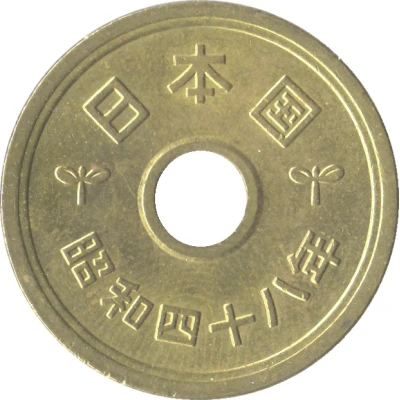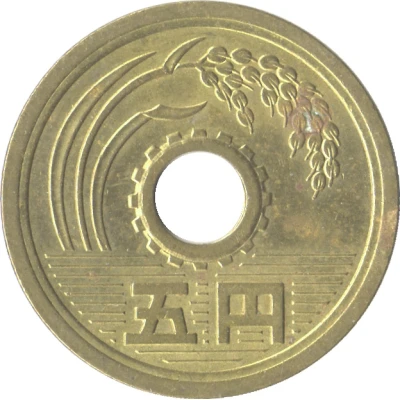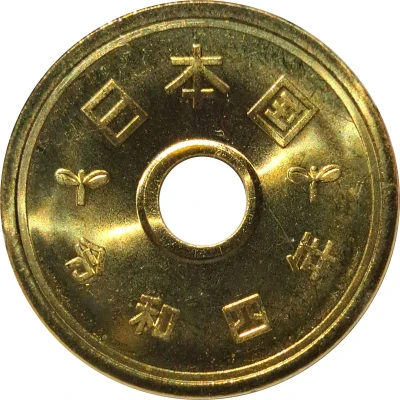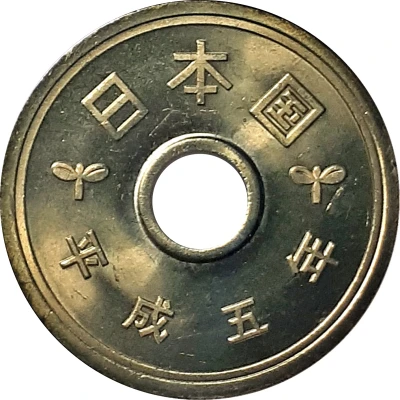
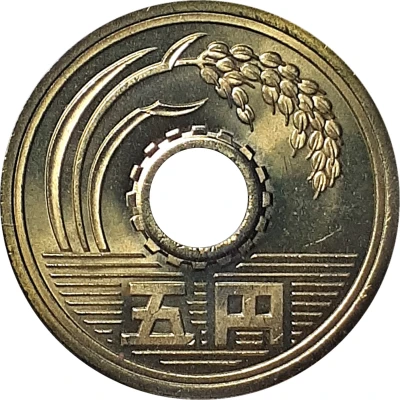

© Rafael Pinheiro Aquino (CC BY-SA)
5 Yen - Heisei
| Brass (60-70% Copper, 40-30% Zinc) | 3.75 g | 22 mm |
| Issuer | Japan |
|---|---|
| Emperor | Heisei (1989-2019) |
| Type | Standard circulation coin |
| Years | 1-31 (1989-2019) |
| Calendar | Japanese - Heisei era |
| Value | 5 Yen 5 JPY = USD 0.034 |
| Currency | Yen (1871-date) |
| Composition | Brass (60-70% Copper, 40-30% Zinc) |
| Weight | 3.75 g |
| Diameter | 22 mm |
| Thickness | 1.51 mm |
| Shape | Round with a round hole |
| Technique | Milled |
| Orientation | Medal alignment ↑↑ |
| Updated | 2024-10-05 |
| Numista | N#2676 |
|---|---|
| Rarity index | 4% |
Reverse
Large bending stalk of rice representing agriculture on top, water with value at the bottom representing fisheries, and teeth of a cog around the central hole representing industry
Lettering: 五円
Translation: 5 yen
Edge
Plain
Interesting fact
The 5 Yen coin from Japan made of Brass (60-70% Copper, 40-30% Zinc) weighing 3.75g has a unique feature. It has a hole in the center, which is a distinguishing characteristic of Japanese coins. This hole is not just for aesthetics but serves a practical purpose. It allows the coin to be easily distinguishable from other coins, especially for visually impaired individuals. The hole also helps to prevent counterfeiting, as it would be difficult to replicate the coin's unique shape and weight without the hole.
Price
| Date | Mintage | VG | F | VF | XF | AU | UNC |
|---|---|---|---|---|---|---|---|
| 1 (1989) | 200000 | - | - | - | - | - | - |
| 2 (1990) | 200000 | - | - | - | - | - | - |
| 3 (1991) | 220000 | - | - | - | - | - | - |
| 4 (1992) | 250000 | - | - | - | - | - | - |
| 5 (1993) | 250000 | - | - | - | - | - | - |
| 6 (1994) | 227000 | - | - | - | - | - | - |
| 7 (1995) | 200000 | - | - | - | - | - | - |
| 8 (1996) | 189000 | - | - | - | - | - | - |
| 9 (1997) | 212000 | - | - | - | - | - | - |
| 10 (1998) | 200000 | - | - | - | - | - | - |
| 11 (1999) | 280000 | - | - | - | - | - | - |
| 12 (2000) | 226000 | - | - | - | - | - | - |
| 13 (2001) | 238000 | - | - | - | - | - | - |
| 14 (2002) | 242000 | - | - | - | - | - | - |
| 15 (2003) | 275000 | - | - | - | - | - | - |
| 16 (2004) | 283000 | - | - | - | - | - | - |
| 17 (2005) | 258000 | - | - | - | - | - | - |
| 18 (2006) | 247000 | - | - | - | - | - | - |
| 19 (2007) | 201800 | - | - | - | - | - | - |
| 20 (2008) | 168200 | - | - | - | - | - | - |
| 21 (2009) | 132000 | - | - | - | - | - | - |
| 22 (2010) | 130187 | - | - | - | - | - | - |
| 23 (2011) | 108000 | - | - | - | - | - | - |
| 24 (2012) | 103000 | - | - | - | - | - | - |
| 25 (2013) | 102000 | - | - | - | - | - | - |
| 26 (2014) | 87538000 | - | - | - | - | - | - |
| 27 (2015) | 105004000 | - | - | - | - | - | - |
| 28 (2016) | 35064000 | - | - | - | - | - | - |
| 29 (2017) | 33927000 | - | - | - | - | - | - |
| 30 (2018) | 17960000 | - | - | - | - | - | - |
| 31 (2019) | 16946000 | - | - | - | - | - | - |
Values in the table are based on evaluations by sales realized on Internet platforms. They serve as an indication only for 5 Yen - Heisei 1-31 (1989-2019) coin.
